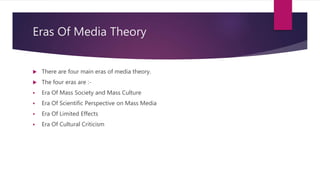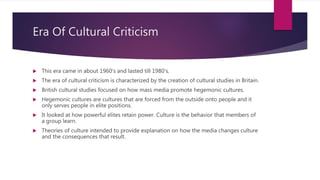Eras of Media Theory
- 1. Eras Of Media Theory
- 2. Eras Of Media Theory There are four main eras of media theory. The four eras are :- Era Of Mass Society and Mass Culture Era Of Scientific Perspective on Mass Media Era Of Limited Effects Era Of Cultural Criticism
- 3. Era Of Mass Society and Mass Culture This era of theory was started in the latter part of the 19th century. Media was seen as influential, but negative. This era is characterized as a time in which people were worried about the power that media had, the power to influence mediocre people. People feared that media would ruin the value of society. Theories that came about during this time are the Propaganda Theory and Magic Bullet Theory.
- 4. Era Of Scientific Perspective on Mass Media This era existed in around 1940-1950. The era emphasized the use of scientific research and experiments that were carefully conducted. The experiments were conducted to prove that media was not as powerful as thought in the previous eras. This era emphasized that people can resist media’s influence in multiple ways. Theories that came under this era are the limited-effects theory, two-step theory and Lasswell’s Model.
- 5. Era of Limited Effects The limited effects era existed in 1950-60s. Limited effects theory was widely supported over mass society theory. At this point, researchers thought there was nothing more to research. Some considered the mass communications field to be dead. However, the communications discipline grew because students started attending journalism schools in numbers never seen before. Elite pluralism and social cognitive theory are notable theories from this era.
- 6. Era Of Cultural Criticism This era came in about 1960’s and lasted till 1980’s. The era of cultural criticism is characterized by the creation of cultural studies in Britain. British cultural studies focused on how mass media promote hegemonic cultures. Hegemonic cultures are cultures that are forced from the outside onto people and it only serves people in elite positions. It looked at how powerful elites retain power. Culture is the behavior that members of a group learn. Theories of culture intended to provide explanation on how the media changes culture and the consequences that result.
- 7. An example of a cultural theory is the political economy theory. The political economy theory is a macroscopic theory of culture because it is concerned about society as a whole and not just individuals. Microscopic theories focus their attention on individuals and not society. The political economy theory studies the powers that power elites have over the institutions that run countries.







